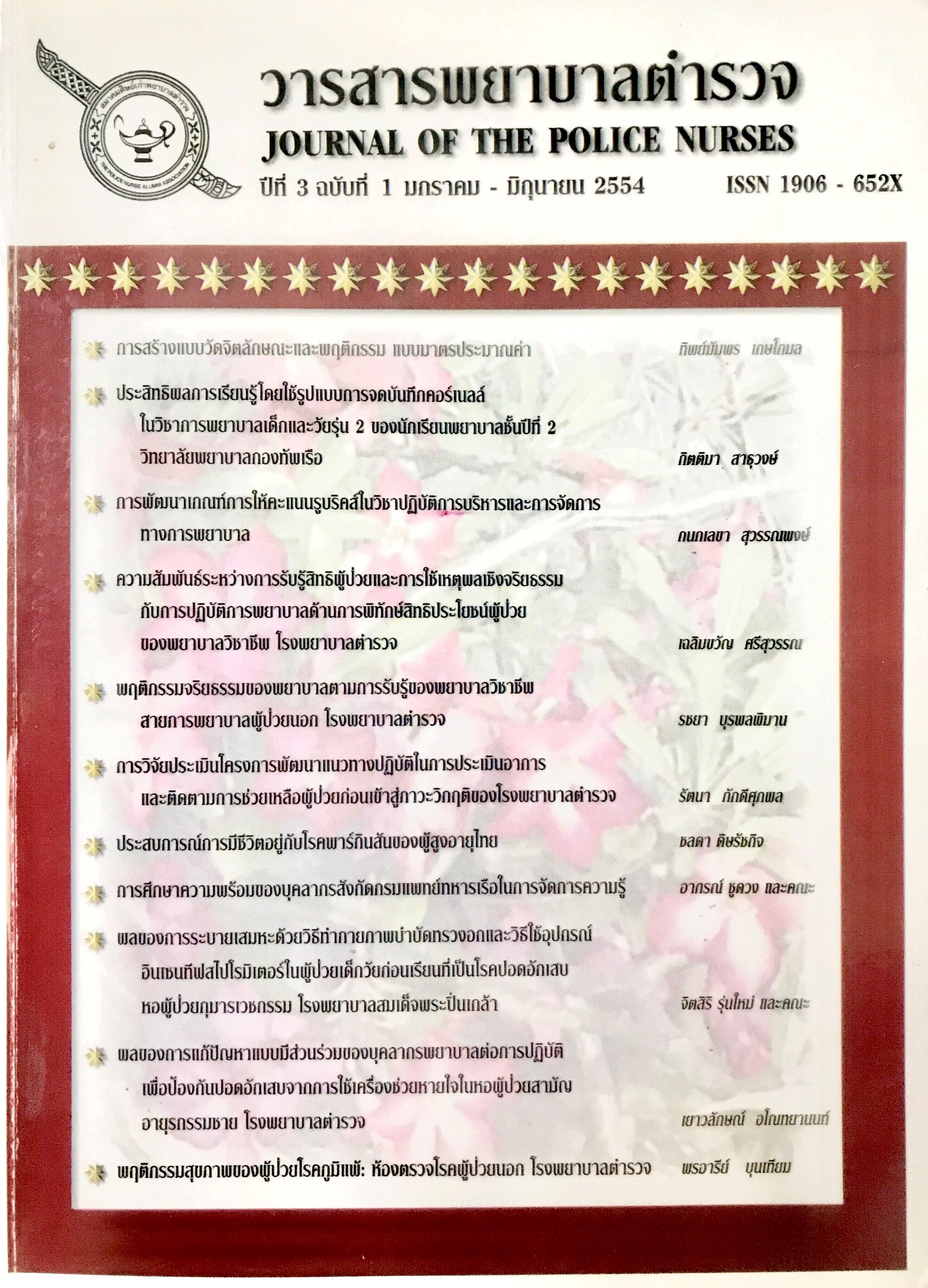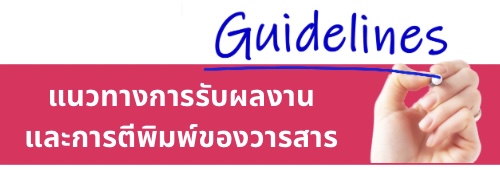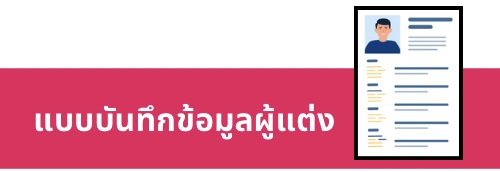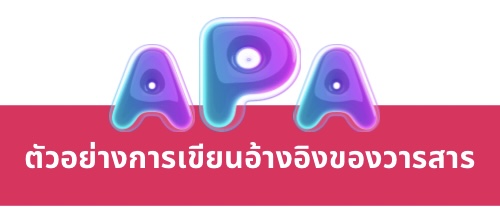ผลของการระบายเสมหะด้วยวิธีทำกายภาพบำบัดทรวงอก และวิธีใช้อุปกรณ์ อินเซนทีฟสไปโรมิเตอร์ในผู้ป่วยเด็กวัยก่อนเรียนที่เป็นโรคปอดอักเสบ หอผู้ป่วยกุมารเวชกรรม โรงพยาบาลสมเด็จพระปิ่นเกล้า
คำสำคัญ:
การระบายเสมหะ, อุปกรณ์อินเซนทีฟสไปโรมิเตอร์, กายภาพบำบัดทรวงอก, Secretion Drainage, Incentive Spirometer, Chest Physiotherapyบทคัดย่อ
บทคัดย่อ
โรคติดเชื้อของระบบทางเดินหายใจในเด็กเป็นโรคที่พบบ่อยมากที่สุดในช่วงวัยก่อนเรียน ซึ่งไม่สามารถไอขับเสมหะออกเองได้อย่างมีประสิทธิภาพจึงจำเป็นต้องได้รับการบำบัดเพื่อช่วยระบายเสมหะโดยการพ่นยาขยายหลอดลมร่วมกับทำกายภาพบำบัดทรวงอก การวิจัยเชิงทดลองนี้ มีวัตถุประสงค์เพื่อเปรียบเทียบผลการระบายเสมหะโดยใช้วิธีการทำกายภาพบำบัดทรวงอกกับวิธีการใช้อุปกรณ์อิน เซนทีฟสไปโรมิเตอร์ (Incentive spirometer) ชนิดคลินิโฟร์ (Cliniflo) ร่วมกับการเคาะปอด ในกลุ่มผู้ป่วยเด็กโรคปอดอักเสบที่มีอายุ 3-6 ปี จำนวน 24 ราย เครื่องมือที่ใช้ในการวิจัยที่คณะผู้วิจัยสร้างขึ้นเอง คือ 1) แบบประเมินประสิทธิภาพการระบายเสมหะ 2) แบบสอบถามความพึงพอใจของผู้ดูแลเกี่ยวกับวิธีการบำบัดทั้งสองอย่าง 3) แบบบันทึกจำนวนวันนอนโรงพยาบาลและยอดค่าใช้จ่ายในการนอนโรงพยาบาลของผู้ป่วยแต่ละรายหลังจำหน่ายแล้ว และผ่านการตรวจสอบความตรงตามเนื้อหาโดยผู้ทรงคุณวุฒิ จำนวน 5 ท่านวิเคราะห์ข้อมูล ลักษณะของกลุ่มตัวอย่าง ความพึงพอใจของผู้ดูแล โดยใช้การแจกแจงความถี่ ร้อยละ ค่าเฉลี่ยเลขคณิต และค่าส่วนเบี่ยงเบนมาตรฐาน เปรียบเทียบความแตกต่างของค่าเฉลี่ยลักษณะกลุ่มตัวอย่างทั้งสอง ในด้านสมรรถภาพปอด อัตราการเต้นของหัวใจ อัตราการหายใจ ค่าความอิ่มตัวของออกซิเจนในเลือดแดง จำนวนวันนอนโรงพยาบาล และยอดค่าใช้จ่ายในการรักษาพยาบาล โดยการทดสอบด้วยค่าทีแบบอิสระ
ผลการศึกษา พบว่า กลุ่มผู้ป่วยที่ได้รับการระบายเสมหะโดยใช้อุปกรณ์อินเซนทีฟสไปโรมิเตอร์ (Incentive spirometer) มีสมรรถภาพปอดดีกว่า คะแนนความพึงพอใจโดยรวมของผู้ดูแลสูงกว่า จำนวนวันนอนโรงพยาบาลสั้นกว่า และยอดค่าใช้จ่ายในการรักษาพยาบาลต่ำกว่ากลุ่มผู้ป่วยที่ได้รับการระบายเสมหะโดยการทำกายภาพบำบัดทรวงอกอย่างมีนัยสำคัญทางสถิติ (P < 0.05) จึงน่าจะใช้วิธีการระบายเสมหะโดยใช้อุปกรณ์อินเซนทีฟสไปโรมิเตอร์ (Incentive spirometer) ชนิดคลินิโฟร์ (Cliniflo) ร่วมกับการเคาะปอด เป็นอีกทางเลือกหนึ่งในการระบายเสมหะแทนวิธีการเดิมในผู้ป่วยเด็กวัยก่อนเรียนที่เป็นโรคปอดอักเสบ
The Effect of Using Chest Physiotherapy and Incentive Spirometer Device for Secretion Drainage in Preschool Children with Pneumonia in Pediatric Ward of Somdejprapinklao Hospital
Abstract
Respiratory infection disease is the most common health problem in children, especially preschool because they cannot cough to remove their secretion by themselves. So, treatments for secretion drainage with bronchodilator nebulizer and chest physiotherapy are necessary. The objective of this experimental research was to compare chest physiotherapy method and using Incentive spirometer device with chest percussion for secretion drainage. The subjects were twenty four 3-6 years pneumonic patients. Research instruments were; 1) The effect of secretion drainage assessment 2) The satisfaction recorded by caregivers about 2 types of patient treatments 3) The patients length of hospital stay and expense record. Five experts in pediatric medicine and pediatric nursing confirmed the content validity of research equipment. Characteristic of subject and satisfaction of caregivers were analyzed by percent, mean, and standard deviation. The different of lung function, heart rate, respiratory rate, oxygen saturation, length of hospital stay, and expense in two group data were analyzed by Independent t-test.
The results revealed that patients in group 2 had better lung function, a shorter length of stay and lower hospital expense and also their caregivers had higher satisfaction than group 1 with significantly different (P < 0.05). This study recommended that using Incentive spirometer device; Cliniflo and only performing chest percussion for preschool children with pneumonia are effective for secretion drainage treatment.
Downloads
ดาวน์โหลด
รูปแบบการอ้างอิง
ฉบับ
ประเภทบทความ
สัญญาอนุญาต
ผลงานที่ได้ตีพิมพ์แล้วจะเป็นลิขสิทธิ์ของวารสารพยาบาลตำรวจ















